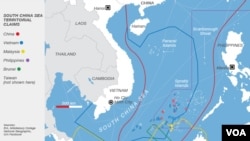MANILA —
The Philippines' top diplomat this week called for a moratorium on building activities by China that he says “escalate tension” on hotly-contested features in the South China Sea. At the same time, Philippine officials and concerned citizens are trying to keep the country’s only civilian-inhabited island in the disputed Spratly Islands habitable for its tiny population.
About 150 people chanted, “Get out China!” at a recent rally in Manila’s business district protesting China’s reclamation activity at several reefs in the Spratly Islands.
Carlos Celdran, a Manila artist and historian who was among them, says the ongoing dispute between China and the Philippines is all about tapping the resources in the South China Sea. Brunei, Malaysia, Vietnam and Taiwan also have claims in the sea, which has abundant fishing, potentially huge hydrocarbon reserves and is a heavily travelled trade route.
Celdran says China doing reclamation work, drilling in contested waters and taking other actions to assert its claims is “so old-fashioned.”
But he also says Filipinos should “get involved [in] the issue.”
“We completely dropped the ball when it came to developing Pagasa shoal and the Kalayaan Islands," Celdran said. " It’s completely unsustainable. It’s an empty island with no water, no infrastructure, no electricity. So the threat of people leaving that island and leaving it empty for [China] to come in is really high.”
Celdran refers to the Spratlys by their local name, the Kalayaan Group of Islands. The Philippines claims nine islands, reefs and shoals in the Spratlys, which has hundreds of formations. Among them, the 37-hectare Pagasa Island, internationally known as Thitu, has up to 150 mostly civilian residents at any given time.
A few months ago, Celdran and a small group of friends created a fledgling project to support Thitu. Their goal is to bolster its infrastructure and education system, which Celdran says is “totally doable.” They plan to send water filtration and solar power systems. So far, they have delivered elementary schoolbooks to the 30 children attending the one-room school.
Kalayaan Mayor Eugenio Bito-onon had the school built two years ago. He says before that children attended school in Palawan, an island province some 500 kilometers to the east.
Bito-onon says Thitu municipality’s residents are mostly local government workers and fisherfolk. He says it is at the lowest end of the country’s socio-economic structure. Its budget for social services and infrastructure is $223,000.00, a slight increase over last year.
Bito-onon says this is barely enough to offer basic services, such as healthcare. There is no doctor on the island, whose airport runway is unusable.
“But if we have facilities, relevant facilities like a good airport, a civilianized airport and there are regular flights and then we have a nice harbor and good sea craft, everything will just go normal. No problem,” Bito-onon said.
On Monday China’s Foreign Ministry Spokeswoman Hua Chunying said the Philippines’ call for stopping construction activities in the South China Sea islands was “totally unreasonable.” She said China, which says it has “indisputable sovereignty” over about 90 percent of the South China Sea, had a right to do what it wanted on its claimed territory. Hua says the Philippines has illegally occupied some of the disputed islands and is carrying out construction work.
But Ian Storey, a senior fellow at Singapore’s Institute of Southeast Asian Studies says the Philippines is simply “playing catch-up” to its neighbors. Some of them have well-developed infrastructure on their claimed islands.
“It’s one thing to repair a runway or to add… what the Philippines is doing, maybe adding a school, that kind of thing. It’s quite another to do reclamation work,” Storey said.
Storey points out under a non-binding agreement between the 10-member Association of Southeast Asian Nations and China there is nothing that prohibits upgrading of existing features. However, he says reclamation stretches the limits and “violates the spirit” of the declaration.
Officials suspect China’s reclamation work is laying the groundwork for military infrastructure.
Another analyst, Sam Bateman with the S. Rajaratnam School of International Studies in Singapore, says how the reclamation work will be used to justify maritime claims in the future could stir tensions further.
He says the Philippines non-military goals at Thitu help strengthen its claims.
About 150 people chanted, “Get out China!” at a recent rally in Manila’s business district protesting China’s reclamation activity at several reefs in the Spratly Islands.
Carlos Celdran, a Manila artist and historian who was among them, says the ongoing dispute between China and the Philippines is all about tapping the resources in the South China Sea. Brunei, Malaysia, Vietnam and Taiwan also have claims in the sea, which has abundant fishing, potentially huge hydrocarbon reserves and is a heavily travelled trade route.
Celdran says China doing reclamation work, drilling in contested waters and taking other actions to assert its claims is “so old-fashioned.”
But he also says Filipinos should “get involved [in] the issue.”
“We completely dropped the ball when it came to developing Pagasa shoal and the Kalayaan Islands," Celdran said. " It’s completely unsustainable. It’s an empty island with no water, no infrastructure, no electricity. So the threat of people leaving that island and leaving it empty for [China] to come in is really high.”
Celdran refers to the Spratlys by their local name, the Kalayaan Group of Islands. The Philippines claims nine islands, reefs and shoals in the Spratlys, which has hundreds of formations. Among them, the 37-hectare Pagasa Island, internationally known as Thitu, has up to 150 mostly civilian residents at any given time.
A few months ago, Celdran and a small group of friends created a fledgling project to support Thitu. Their goal is to bolster its infrastructure and education system, which Celdran says is “totally doable.” They plan to send water filtration and solar power systems. So far, they have delivered elementary schoolbooks to the 30 children attending the one-room school.
Kalayaan Mayor Eugenio Bito-onon had the school built two years ago. He says before that children attended school in Palawan, an island province some 500 kilometers to the east.
Bito-onon says Thitu municipality’s residents are mostly local government workers and fisherfolk. He says it is at the lowest end of the country’s socio-economic structure. Its budget for social services and infrastructure is $223,000.00, a slight increase over last year.
Bito-onon says this is barely enough to offer basic services, such as healthcare. There is no doctor on the island, whose airport runway is unusable.
“But if we have facilities, relevant facilities like a good airport, a civilianized airport and there are regular flights and then we have a nice harbor and good sea craft, everything will just go normal. No problem,” Bito-onon said.
On Monday China’s Foreign Ministry Spokeswoman Hua Chunying said the Philippines’ call for stopping construction activities in the South China Sea islands was “totally unreasonable.” She said China, which says it has “indisputable sovereignty” over about 90 percent of the South China Sea, had a right to do what it wanted on its claimed territory. Hua says the Philippines has illegally occupied some of the disputed islands and is carrying out construction work.
But Ian Storey, a senior fellow at Singapore’s Institute of Southeast Asian Studies says the Philippines is simply “playing catch-up” to its neighbors. Some of them have well-developed infrastructure on their claimed islands.
“It’s one thing to repair a runway or to add… what the Philippines is doing, maybe adding a school, that kind of thing. It’s quite another to do reclamation work,” Storey said.
Storey points out under a non-binding agreement between the 10-member Association of Southeast Asian Nations and China there is nothing that prohibits upgrading of existing features. However, he says reclamation stretches the limits and “violates the spirit” of the declaration.
Officials suspect China’s reclamation work is laying the groundwork for military infrastructure.
Another analyst, Sam Bateman with the S. Rajaratnam School of International Studies in Singapore, says how the reclamation work will be used to justify maritime claims in the future could stir tensions further.
He says the Philippines non-military goals at Thitu help strengthen its claims.











